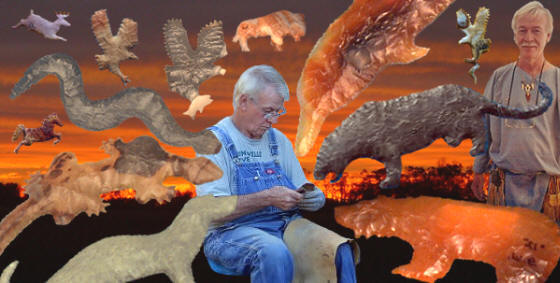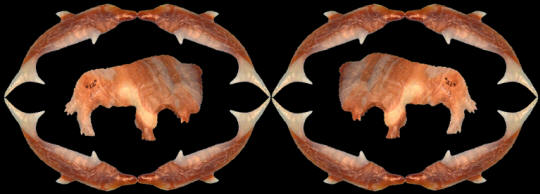|
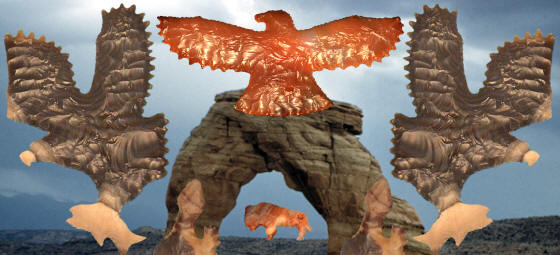
"I live in north
Tennessee, I live on the Tennessee River with my wife Tereena, I have
been making primitive tools and Weapons since the age of 10."
Don Wilcox, "Knapperdon," flintknappers.com.
"Don has been a great
artist all these years, He has been knapping for the last 19 years and
hunting relics for the last 56 years---. Don is a great person."------2013,
Tereena Wilcox, Personal Communication.
"(years
ago) I made bows and arrows using
authentic points until I later learned to make them. They were good
enough to take out chickens, rabbits and squirrels."------2013, Don Wilcox, "Personal
Communication."
"A few
knappers make "eccentrics," that is, non-point forms, which usually have
the edges flaked with elaborate notches, barbs, or even silhouettes of
heads or animals."------2004, John C.
Whittaker, "American Flintknappers, Stone Age Art In The Age Of
Computers" p. 239.
"(Mayan
culture) Eccentric flints are chipped
flint objects of unusual, essentially non-utilitarian forms, including
such things as rings, or circles, crescents, S-shaped figures and
various life-forms (such as humans,
bats, jaguars,
dogs, scorpions and centipedes)."----1972,
Gordon R. Willey, "Eccentrics," The Artifacts Of Altar De
Sacrificios, p. 181.
"Around 56 bifacially worked flint animals (such
as hippopotamus & ibex) are known. As
over half the examples known are attributable to Predynastic
Hierakonpolis (Egypt)"---------1999,
Carolyn Anne Graves-Brown, (from doctorate thesis, reference Hendrickx) "The
Ideological Significance Of Flint In Dynastic Egypt, Vol. 1," p. 485.
"(in
Predynastic Egypt)---clay was
molded into animal figurines and little erratically shaped flints were
kept, possibly as amulets."--------1984,
Michael A Hoffman, "Egypt Before The Pharaohs, The Prehistoric
Foundations Of Egyptian Civilization," p. 154.

MODERN-MADE ANIMAL ART
NORTH AMERICA
PRESENT DAY
Don Wilcox began experimenting with
flintknapping at the age of 10 and from that point on its been a
life-long interest. He began making bows and arrows at an early age and
tipped his arrows with old points. But it wasn't long before he could
make his own. He learned basic flint knapping on his own by studying the
bits and pieces of flint he found in cultivated fields. It took about
three years to learn flint knapping when he later began doing it in a
more serious way. His wife, Tereena, says that Don's first thought of
making animal forms was at a Pow-Wow at Tuscumbia, Alabama when a friend
asked him, "have you ever tried to make animal shapes?" |
|

PHOTO CREDIT ART GERBER----COMPUTER
ALTERED BY PETE BOSTROM
DOG
BY DON WILCOX
This dog looks as if it's about to
catch a stick in its mouth, in this
computer altered landscape. Don thought it was probably
made of a white form of Arkansas Novaculite. |
|
|
Among the flint knapping community Don goes by the
handle "Knapperdon." He says he was able to learn more about the
subject when he discovered knap-ins and could see what types of
tools, and techniques other knappers were using. Don uses copper tools but
he can also work with the more traditional
tools, like the ones made of antler. |
|
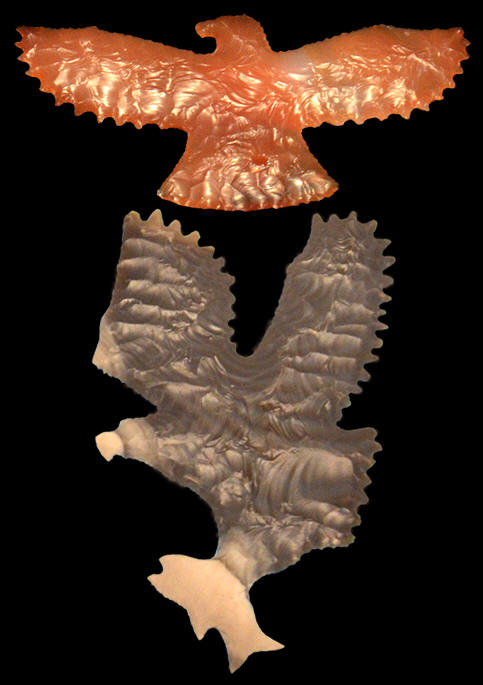
PHOTO CREDIT ART GERBER----COMPUTER
ALTERED BY PETE BOSTROM
EAGLES
BY DON WILCOX
Both of these eagles are well done. They illustrate a high level of
flint knapping skill and artistic ability. Their forms are complex
and impressive to look at. The lower example is especially nice. Don
was able to enhance the finished piece by highlighting the fish and
beak with the lighter colored stone. The upper eagle is made of
semi-translucent orange Brazilian agate and the lower eagle is made
of a variety of stone that is referred to as Polish chocolate flint. |
|
|
Don considers himself to be a primitive artist. He
bases his art on wildlife and Native Americans and that influence may
come from his ancestry. Both he and his wife Tereena are descendants of
Native American Indians. |
|
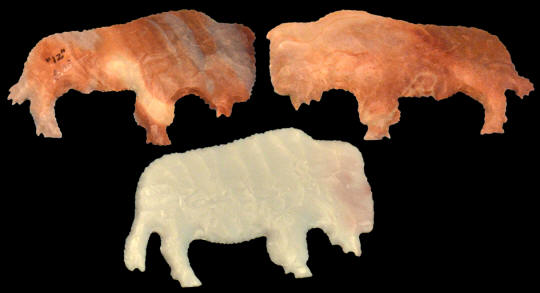
PHOTO CREDIT ART
GERBER----COMPUTER ALTERED BY PETE BOSTROM
BUFFALO
BY DON WILCOX
Don says he began making
buffalo art figures early on. These are good representative examples.
The two upper buffalo were made from what Don calls Painted Buffalo
chert from Tennessee. The lower buffalo is made of white Arkansas
Novaculite. |
|
|
Don says that he likes to make unique pieces
that are pleasing to gaze upon and study. Each one of his animal forms
are certainly different and unique in that way. |
|
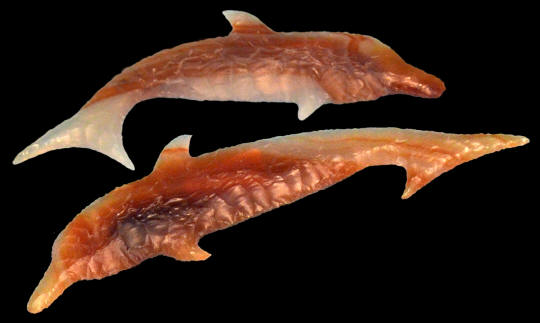
PHOTO CREDIT ART
GERBER----COMPUTER ALTERED BY PETE BOSTROM
BOTTLENOSE DOLPHINS
BY DON WILCOX
These pieces have very good
pleasing forms. Their long snouts give them away as representing
bottlenose dolphins. The colorful stone greatly enhances their
appearance. They were made from semi-translucent white, yellow, red and
orange Brazilian agate. |
|
|
Don is a carver of stone, antler, wood and bone. But his main
interest is in stone and more specifically in flaked stone. Besides his
animal & nature figures he also makes a wide variety of both traditional
and "exotic art" points. He has made everything from Clovis and Pinetree
points to Moustache Simpsons. |
|
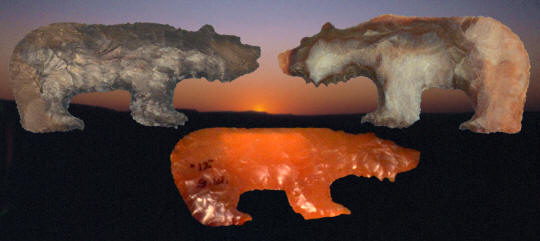
PHOTO CREDIT ART
GERBER----COMPUTER ALTERED BY PETE BOSTROM
BEARS
BY DON WILCOX
Bears are one of the early
animal forms that Don made. He says he liked making bears and buffalo. These are good
representative examples of his bear figures. |
|
|
Don has used all types of chert, Jasper, and agate for his
flint knapped animal art. He has used the more common forms of stone,
like Dover, Knife River, Arkansas Novaculite and Brazilian Agate. But
he's also used more rare forms, like Horse Creek or a particularly rare
type he calls Painted Buffalo that outcrops in Tennessee. |
|
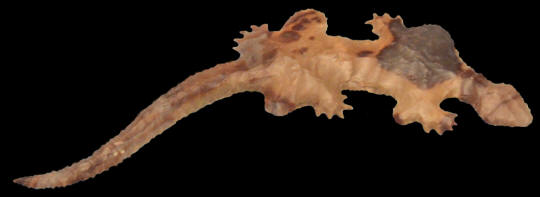
PHOTO CREDIT ART
GERBER----COMPUTER ALTERED BY PETE BOSTROM
LIZARD
BY DON WILCOX
Don has made
some fairly complicated art forms in flaked stone. This lizard would be
one of them. It's an impressive piece. |
|
|
Don Wilcox has probably made as many or more
"quality" animal forms than any other modern knapper. Early on, he liked to
make bears and buffalo. But in recent years he's made a wide variety of
animal forms, like snakes, lizards, squirrels, horses, eagles, dogs,
dolphins, turtles, panthers, seahorses, stingrays, frogs, butterflies,
deer, kangaroos, and dragons. The largest "animal" he's made so far
was a black panther that measured 6 inches (15.2 cm) long and 2 inches
(5.1 cm) wide. |
|
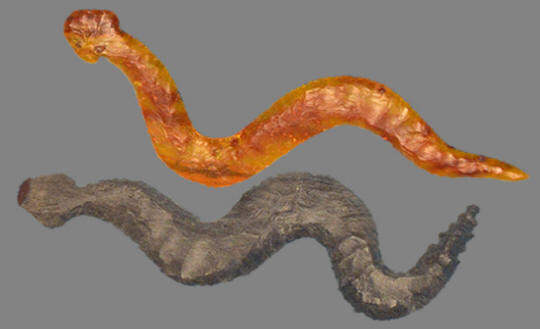
PHOTO CREDIT ART
GERBER----COMPUTER ALTERED BY PETE BOSTROM
SNAKES
BY DON WILCOX
Both of these snakes have highly recurved edges that conveys the
image of the snake very well. Both have a diamond shaped head and
the lower snake has a rattle on its tail. The upper snake is made of
Brazilian agate and the lower snake is made of Dover chert. |
|
|
Flint knapped animal art is not unique, only to modern
flint knappers. The Mayan culture produced large numbers of natural looking
and stylized forms of scorpions, centipedes and bats. Also, during the Predynastic period
in Egypt, craftsmen produced animals in the form of ibex and
hippopotamus. The ancient forms relate to important cultural ideas. The
modern forms are works of art. |
|
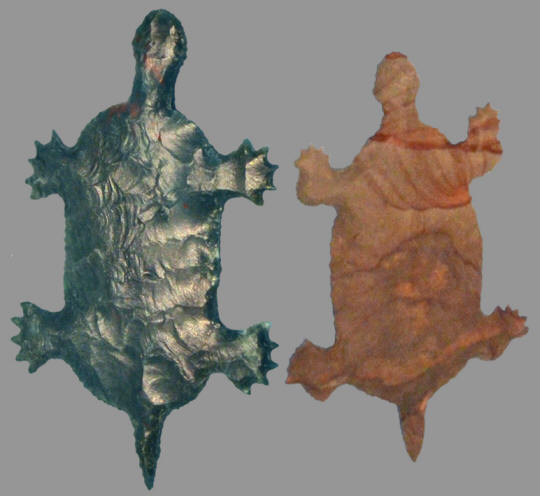
PHOTO CREDIT ART
GERBER----COMPUTER ALTERED BY PETE BOSTROM
TURTLES
BY DON WILCOX
All of Don's animal figures
are easy to identify. These are obviously overhead views of turtles,
complete with head, feet, claws and tail. The green turtle is made of
fancy Jasper from India and the one on the right is made of Painted
Buffalo chert from Tennessee. |
|
|
Don sells most of his knapped animal art. But he and
his wife has wisely kept some of his better pieces. It's amazing how the
art of flint knapping keeps evolving and moving in different directions.
No one in the days of "gray ghosts" and McCormick's Folsom's would ever
have imagined that so many people would become so deeply involved in
flint knapping. Don Wilcox's knapped animal art represents another high
point in this unique form of art. |
|
"REFERENCES"
2013, flintknappers.com, "Knapperdon,"
2013, carverscorner.com, "Don Stone Man."
2004, Whittaker, John C., "American
Flintknappers, Stone Age Art In The Age Of Computers" p. 240.
1999, Graves-Brown, Carolyn Anne, (from doctorate thesis,
reference Hendrickx) "The Ideological Significance Of Flint In
Dynastic Egypt, Vol. 1," p. 485.
1984,
Hoffman, Michael A, "Egypt Before The Pharaohs, The Prehistoric
Foundations Of Egyptian Civilization," p. 154.
1972,
Willey, Gordon R., "Eccentrics," The Artifacts Of Altar De
Sacrificios, p. 181.
Personal Communication, Don Wilcox.
Personal Communication, Tereena Wilcox.
Personal Communication, Tony Podkanowicz
|
|
RECENT
LISTINGS HOME
ORDERING |
